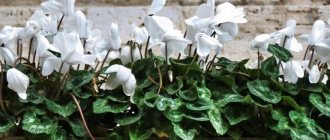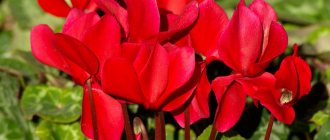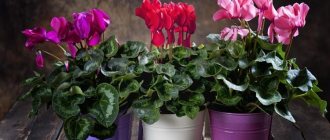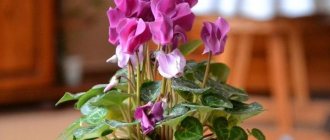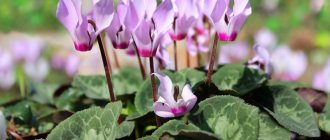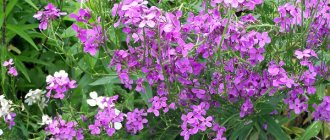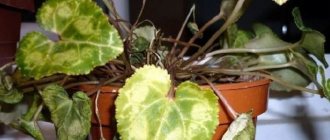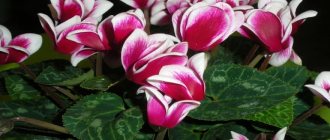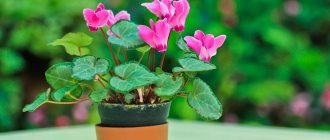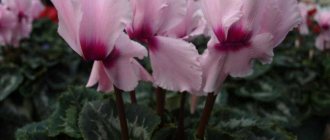The African variety of cyclamen is characterized by the appearance of peduncles first, and already at the end of flowering (in September) it begins to produce young leaves.
African cyclamen is deciduous and sheds its leaves during the dormant period. He rests in a cool place (no more than 15 degrees Celsius), but due to his heat-loving nature, he is very afraid of low temperatures and, oddly enough, the sun. When grown in open ground, it needs shade and additional shelter for the winter. Of all types of cyclamen, African has the fastest growth rate and develops quickly.
Free-loving alpine cyclamen
One of the wild plant species is alpine cyclamen.
For a long time it was considered extinct, but even today the flower can still be found, most often in natural conditions. The variety is characterized by the arrangement of the inflorescence petals at right angles (vertically standing), in addition, they curl slightly. Alpine cyclamen blooms in spring, emitting a delicate honey scent; the main color of the flowers is various shades of pink. The leaf blade has an oval shape and is slightly grey.
With deep colors
In general, the combination of catchy pink shades with deep colors is still poorly mastered in modern design - pink is often combined with chocolate and dark gray, and this is already hackneyed. But such an interesting combination of hot pink and blue is almost never used - take note!
Fuchsia is usually combined with silver, but this is not a dogma - as you can see, hot pink also goes well with gold, and it perfectly tolerates the craziest golden vignettes. The catchy, impudent character does not in any way contradict the same catchy gold or shiny chrome. But old bronze and shabby brass are bad partners for fuchsia.
So, working with hot pink in the interior is not easy. The main thing to do when introducing fuchsia, cyclamen or Barbie color into the interior is to accurately select other colors to match it. Remember - the more contrast the interior, the less durable it is. The more other bright colors from a catchy palette, the more fun the interior is, but it needs a white background. The more gray and cream the color, the calmer the interior and the easier it is to perceive bright pink.
Endangered species - Colchis cyclamen
Pontic cyclamen, as this variety is also called, has recently become a plant that is protected from mass destruction.
The flower is listed in the Red Book, although its plantings are still quite large. But as a result of the active use of cyclamen for medicinal purposes and for making bouquets, its numbers are decreasing every year. Colchis cyclamen is characterized by slow growth, and the seeds ripen throughout the year. Roots grow throughout the corm, leaves grow simultaneously with the appearance of flower stalks. The inflorescences are small, pink, with a more richly colored edge, from which a strong aroma emanates. The pattern on the leaf plate is absent or weakly expressed. Pontic cyclamen prefers moist and shady places.
The flowering time of the plant depends on the growing conditions. In nature, flowering lasts no more than 1.5 months and occurs at the beginning of autumn (from September to October). At home, the bush blooms already in July and pleases the eye until mid-autumn.
Reproduction
If necessary, alpine violet can be propagated in several ways, but the most popular are: seeds and tubers. The flower also takes root well from the leaves. The type of reproduction depends on the time of year.
Tubers
Only after a period of rest .
This method can only be used when the flower has “fallen asleep.” The tuber is removed from the pot and divided into several parts, then they are dried and each part must be sprinkled with activated carbon powder. And then plant them in different containers for constant growth.
And here, the most important thing is to pay maximum attention to each part of the tuber. Before the first shoots appear, the plant may simply rot and die.
From seeds
It will take a lot of time and effort. Seeds are obtained from the main plant, and especially for this, cyclamen is artificially pollinated - transferring pollen from one flower to another with a soft brush. The procedure should be done early in the morning and repeated several times. And to speed up the process, primrose is additionally fertilized with potassium sulfide and superphosphate.
- If everything was done correctly, then seeds capable of reproduction will soon form. It is best to sow before flowering, in August. The seeds are completely filled with sugar solution, the spoiled ones are discarded (those that float to the surface), and then prepared for planting.
- The soil is selected that is suitable for transplanting flowering plants. Water the soil well, then distribute small primrose seeds evenly over it and sprinkle with a thin layer of soil. Cover the container with film - it will speed up germination and create condensation. Until the first shoots appear, the temperature under the film should reach 19 - 21 degrees.
- From time to time the container needs to be ventilated and sprayed with a spray bottle, and after 5 - 7 weeks shoots will appear. The time has come to remove the film and provide the sprouts with constant care and attention.
- When the first 3–4 leaves grow on the trunk, the cyclamen must be plucked, and 10–13 months after planting, it is transplanted into pots for permanent habitat.
The many faces of Greek cyclamen
Already from the name it becomes clear that the Greek cyclamen came to us from Greece; it also grows freely on the islands of Crete, Cyprus and on the warm coast of Turkey.
Depending on the specific variety, cyclamen can have either heart-shaped or simply oval leaves. They are painted in different shades of green; lighter spots with a characteristic pattern clearly appear on the surface. As for the color of the inflorescences, all shades of pink predominate here, and in some specimens the base is purple and slightly curved. Peduncles appear both together with the leaves and before them.
In nature, there is also white Greek cyclamen, but it is not grown at home. The white-flowered variety is listed in the Red Book.
Pests
With proper care and compliance with growing recommendations, cyclamen is rarely attacked by pests in home growing conditions. But if you flood it or otherwise violate the conditions for its cultivation, then there is a high probability that various pests will appear on it or it will begin to get sick. The most common pests that can appear if not properly cared for include the following types of insects:
- aphid;
- thrips;
- cyclamen mite.
Let's look at each type of pest in more detail.
Aphids are the most common and most annoying pest. Dealing with them is relatively easy, but only in a situation where you have taken all the necessary measures immediately upon discovering these pests. Aphids suck sap from plant leaves. If you start fighting it immediately after discovery, the flower will quickly recover, and you will not notice any obvious signs of illness. But when left in a pot for a long time, aphids cause long-term damage. Its activity leads to the curvature of flowers and leaves.
Thrips. Today there are many types of these insect pests. Adults can reach a length of up to 2 mm, and are shaped like a spindle. Externally they look like light and mobile insects that are clearly visible on the leaves. Thrips have wings, so they are able to fly from one plant to another. As a result, all cyclamens in your collection become very quickly infected with these parasites. During the activity of these pests, silvery streaks remain on the leaves. The flower itself slows down its growth, and the flowers become deformed and become covered with spots. Therefore, you need to start fighting thrips immediately after they are discovered.
The cyclamen mite is small in size and has a yellowish body. Settles on the lower leaves. If they are present, the edges of the leaves curl and the flowers wither. By following the rules for caring for cyclamen of different varieties, you will eliminate the possibility of pests and also get a strong and beautiful plant with an abundant and long flowering period.
Early flowering Kos cyclamen
From the distant island of Koss a decorative species of cyclamen with the appropriate name came to us. Its lush bushes with rounded heart-shaped leaves produce flower stalks in winter or early spring. The color of the inflorescences can be very diverse: from white to rich shades of pink and even red. Regardless of the base tone, the base of the petal is always darker than the rest of the petal. The leaves themselves appear only at the end of flowering, in the fall, and the cyclamen goes to winter with them.
In Kos cyclamen, roots grow only in the lower part of the corm. It is painted in a very beautiful, rich brown color and has a velvety surface.
Rules for transplantation after purchase
Purchased flowers or those that are more than three years old need to be replanted. To ensure a good development of the plant in new conditions, it is necessary to perform the following actions:
- If the flower is actively flowering, you should not replant the flower. Manipulations are carried out only during the rest period. You need to wait until flowering ends and give it a few days to rest.
- Replanting is required if the plant is placed in unsuitable soil. You don’t have to wait for a state of rest to do this.
- At the end of flowering, the plant must be transferred to a new pot. For young flowers, a container diameter of 6–7 centimeters is sufficient, for older flowers – from 12 to 15 centimeters.
- The tuber removed from the soil mixture is visually inspected for damaged and rotten areas. If any are identified, they are cut off and processed using crushed coal.
- Afterwards it will be moved to a new pot along with a lump of earth.
- The tuber is placed in the middle of the flowerpot, the roots are carefully straightened.
- First, the root system is sprinkled with earth so that 1/3 remains on the surface. The mixture compacts a little.
- The soil is thoroughly moistened. After the soil shrinks, the substrate is added to the container in such a volume that a growth point remains on the surface.
The most frost-resistant ivy-leaved cyclamen
One of the most common types of cyclamen, which is grown in the vast expanses of our homeland, including in indoor floriculture.
Characteristic features of the plant include:
- pink color of the petals (not counting white-flowering hybrids, which do not occur in natural conditions);
- winter-spring flowering period;
- delicate aroma;
- small horns on the inflorescences;
- the rounded shape of the leaves with grooves, thanks to which it resembles ivy foliage.
superficial root system;
Ivy-leaved cyclamen (or Neapolitan) can bloom both before the leaves appear and simultaneously with their blossoming.
It would take a very long time to list the varieties of this diverse plant, and it would be impossible to remember all of its hybrids. Sometimes it is simply impossible to distinguish them from each other, and is it even necessary? They are all very beautiful, no matter when the delicate butterfly flowers bloom and what color they are painted. Let's just grow these amazing types of cyclamens on our plot or in pots and admire their beauty, because sometimes we so miss the feeling of unity with nature.
Cyclamens bloom - video
Cyclamen is an ornamental crop that is distinguished by incredibly beautiful flowering.
At this time, the buds look like “tongues of frozen bright flame.” There are many types and varieties of cyclamen. Each of them differs in height, color and care characteristics. The popularity of this lovely flowering plant has only increased recently. In indoor culture, two types are most common: Persian cyclamen and European cyclamen. Both species captivate with their lovely original flowers.
Pest and disease control
The color of cyclamen leaves and petioles most often changes due to improper water: if it is too hard and has not settled enough. Due to the heat and dryness, the leaves begin to dry out and fly off. Cold, poor drainage and excess moisture provoke the appearance of rot. In this case, it is necessary to urgently remove all damaged areas before the flower dies.
The most serious problem is the cyclamen mite, which will almost certainly destroy the flower. The first symptoms are deformation, curvature and reduction of leaves and peduncles. The second problem is the grape weevil, which causes the shoots to become brittle and die. Do not forget to regularly inspect the flowerpot, immediately change the soil and treat the seedlings with insecticides.
Photo: ncsupdicblog.blogspot.com
Description of all varieties with names and photos
Caucasian
The plant is 10 cm high. Dark brown root tubers are concentrated underground and partially above its surface. Their diameter is 8 cm. Round, wintering leaves extend from them. The flowers are concentrated on long stalks. The fruits are spirally twisted. Flowering begins in February-March, and fruiting begins in March-June. Reproduction is vegetative and by seeds. If the second method is chosen, the seeds will germinate in the spring of next year.
Victoria
This variety is excellent for winter flowering. The height of the plant is 30 cm. The leaves have a unique color - light green with silver veins. Flowering begins at the end of autumn and lasts until spring. Cyclamen Victoria is characterized by double flowers. Care is simple and no different from caring for other types of cyclamen grown at home. But if left untreated, the plant will die.
Garden
This plant is presented in two types of winter-hardy cyclamens - summer and autumn alpine violet. Summer violet is cyclamen purple. Its flowering lasts from July to September. Autumn – Cyclamen Neapolitan. Its leaves are decorated with a silver pattern. Flowering begins in September. Garden cyclamens should be grown in partial shade, in a place where there are no drafts or wind. The soil should be calcareous and enriched with humus. Garden cyclamen gradually grow, multiplying independently and forming colorful clearings.
Ivy (Neapolitan, pink)
In European countries, the culture of this variety is bred as naturalization - to decorate gardens and parks. Ivy-leaved cyclamen is characterized by independent development.
This variety is one of the most frost-resistant. It differs from the rest in its jagged leaves, which are very similar to ivy leaves. On each leaf bend there are unique horns, characteristic only of this type of plant. This variety is not grown at home.
Lush flowering will begin from early to mid-autumn. The flowers are beautiful pink. The development of the root system occurs from the top of the tuber, so it is planted at a depth of 10 centimeters.
Terry
This is an indoor plant that was obtained as a result of complex selection by crossing several species (ornamental and wild varieties). Double flowers are large and form 13 petals. There are situations when 2 simple flowers are formed on one bush. It looks impressive and unusual. The leaves are different from ordinary cyclamens. They are larger in size. The plant looks very beautiful, even in the absence of flowers, when the cyclamen is in a dormant period.
Purple
This variety has become widespread in European countries. It grows both in the wild and in gardens. This is one of the northernmost cyclamens. He lacks pronounced peace. It remains with leaves throughout the year.
Flowering occurs in summer and lasts until mid-autumn. The height of the plant is 10 cm and the width is 8 cm. The leaves can be round or heart-shaped. Their surface is glossy, dark green in color, up to 8 cm long. The flowers, curved upward, are distinguished by their aroma. Their color ranges from pale carmine to red. Flowers bloom in mid-summer.
Kossky
This flower received this name in honor of its homeland, Kos Island. Some of its populations can be found almost all over the world. The tubers of the plant are velvety to the touch and have a dark brown color. The development of the root system occurs from the lower region of the tuber. The leaves appear in the fall and are covered with snow throughout the winter.
Taking into account the place of growth, the color of the flowers is subject to change:
- on the Black Sea coast near Turkey - bright pink color;
- in Syria and southern Turkey - pale pink color.
Rating of the best cyclamens of the Persian variety
Lilu
Tuberous perennial plant. Belongs to the Primrose family. The petals are light purple, with a pleasant scent. The length of the peduncle is up to 20 centimeters. Flowering occurs at the end of autumn - beginning of spring. Summer is a period of rest. Sowing of seeds is carried out in August. The first shoots appear after 30 - 40 days. The optimal air temperature is 17 degrees Celsius. After small tubers appear, it is necessary to pick by placing the young shoots in special soil consisting of sand, peat and leaf mixture.
It is advisable to install the pot on the east or north side. Direct sunlight is harmful to the plant. In winter, it is necessary to extend daylight hours. In the summer there will be constant watering (only in the pan) and spraying with settled water at room temperature. Fertilizer is applied no more than twice during the summer months. Preference should be given to nitrogen-potassium compositions.
You can purchase the product at a price of 190 rubles.
cyclamen Lilu seeds
Advantages:
- attractive appearance;
- will decorate any interior of the room;
- easy to care for;
- withstands low temperatures.
Flaws:
- not identified.
Aurora
The perennial flower belongs to the Primrose family. Very beautiful and fragrant. The petals reach a length of 20 cm. They are at rest in the summer. It is propagated by seeds, which are planted in the ground in August, after having been soaked for a day in regular warm water. A layer of earth no more than 1 cm is sprinkled on top and covered with glass or film to create greenhouse conditions. After the growth appears, it is picked into boxes. Prefers shaded areas. Does not tolerate extreme heat and excessive watering.
The average price is 180 rubles.
cyclamen seeds Aurora
Advantages:
- inexpensive;
- beautiful;
- aromatic;
- unpretentious.
Flaws:
- not identified.
Louise
It is in high demand among flower growers. Looks perfect in pots. It will decorate any interior of the room with its presence, making it brighter and more attractive. The flowering period is the winter months. Large-leaved variety. The inflorescences are large, with a fringed edge. The petals are slightly bent back. Color – dark salmon, rich. Can be installed on window sills or in winter gardens.
Seeds are sown at the end of summer. First, they need to be soaked for 24 hours, then sown in the ground to a depth of no more than one and a half centimeters. Water generously and cover with film. Maintain a temperature of 15 - 18 degrees for 30 - 35 days. As soon as the first sprouts appear, the film is removed. If there are two adult leaves, a dive occurs. Choose a mixture of sand and peat. Tubers have only one growth point. It must be handled carefully. If damaged, the flower dies.
Installation locations: eastern and northern windows. If you place it on a southern windowsill, then the plant should be provided with shading. Watering is carried out with soft, settled water at room temperature. Pours into a tray. It is advisable to place the flower in a cool room and keep it there until flowering. Fertilize the soil at least twice a month. In this case, use potassium-nitrogen compounds.
At the end of flowering, a period of rest begins. Watering is reduced, but the earthen ball should remain moist. Withered leaves and flowers are not removed, but are left until completely dry.
Purchase price – 165 rubles.
cyclamen seeds Louise
Advantages:
- beauty;
- ease of care;
- reasonable cost;
- exudes a delicate aroma.
Flaws:
- none.
Ambrella
Amazing cyclamens with small flowers that delight the eye from November to April. Variegated foliage. The petals are found in red and pink shades. Flowers of unusual shape on long stalks. The fragrance is impressive. It is in high demand among domestic flower growers.
The sellers are asking 160 rubles for the product.
Ambrella cyclamen seeds
Advantages:
- attractive appearance;
- easy care;
- long flowering;
- affordable price.
Flaws:
- not installed.
Apollo
A distinctive feature of the variety is its very long and durable peduncles, reaching a length of 30 centimeters. Suitable for decorating bouquets. The size of the flowers is from 6 to 7 centimeters. The petals are double, there are from 7 to 11 pieces in one bud. It grows quite quickly. Not susceptible to diseases and pest attacks. Reproduction is carried out through seeds. Adapts quickly to room conditions. You can sow planting material at any time of the year. It is advisable to choose early spring or late summer. The seeds must be soaked to swell. It is enough to put it in a damp napkin or cloth for a day. Seeds are sown in the ground to a depth of no more than 1 centimeter. Young bushes rest in the summer, while adults shed their leaves at this time.
The average cost is 189 rubles.
cyclamen seeds Apollo
Advantages:
- disease resistance;
- attractive appearance;
- rich colors;
- abundance of flowering.
Flaws:
- not found.
General rules of care
Air humidity
Cyclamen is a plant for which high humidity is important. During growth, the leaves should be sprayed. Stop spraying when flowering begins. To increase humidity levels, you need to create a water mist near the flower. To do this, place it on a tray with wet pebbles. With the onset of winter, place it at a great distance from central heating radiators.
Watering
During flowering, water the plant so that the liquid does not penetrate the roots. Distribute the moisture evenly to avoid overflow. But the soil should not dry out either.
Transfer
It is advisable to transplant when new leaves form on the plant. This falls at the end of June. For transplantation, use a low container that is quite wide. When performing a transplant, take into account the following point: the root system of cyclamens is completely covered with earth. Until the roots are thoroughly established, water infrequently, and only then increase the moisture.
Feeding
Fertilizers must be applied once every 2 weeks. It is necessary to use mineral compositions intended for flowering crops. Apply fertilizers from the moment the leaves develop and continue until the plant blooms.
Diseases and pests
Cyclamen is very often affected by infectious diseases and pests.
Most often it is attacked by the cyclamen mite. It can be detected by the presence of deformed leaves, crooked peduncles and curved buds. Detecting a tick infestation in the early stages is not easy. In case of severe damage, drugs do not always cope with parasites, so you will have to get rid of the flower. Among the diseases, the plant is affected by gray rot and powdery mildew. These are fungal diseases. If the leaves begin to curl and dry out, then an urgent need to treat with Fudnazol.
Cyclamen is an ornamental plant, the peculiarity of which is that it can be grown at home and in open ground.
Does not make any special demands on the type of soil and is not picky about care.
But if you make a number of mistakes, this is fraught with the development of diseases that can ruin the flower.
If you find an error, please select a piece of text and press Ctrl+Enter.
Cyclamen or dryer is a perennial herbaceous plant of the Myrsinaceae subfamily, Primrose family. The homeland of the flower is considered to be the Mediterranean coast, Asia Minor and North-East Africa. Types of cyclamen have different names, which depend on where the flower grows. We will talk about some of them in more detail.
Subtleties of cultivation
It is worth noting that cyclamen feels great in bright, diffused light and coolness (from 6 to 12 degrees Celsius). It is advisable to regularly ventilate the premises, however, drafts should be avoided. The humidity level in the room should be high, for this purpose constant spraying is provided, especially in the hot summer. Fertilizing with complex fertilizers should not be overlooked. You need to be careful with the consistency. It is better to underfeed the plant.
Watering is of no small importance. It should be regular and sufficient, but not excessive. It is advisable to use bottom watering. To do this, you need to place a container under the pot and fill it with water. This will minimize the possibility of rotting of the growing point.
How to choose a reproduction method? Experts recommend not to experiment and propagate the flower by seeds. You can also try vegetative division of the tuber, provided that there is not one growing point, but several. However, in most cases such experiments end in failure.
Flowering directly depends on proper care. In order for a plant to delight with its beauty for a long period, it is necessary to create ideal conditions for it:
- a large amount of diffused sunlight (direct rays can negatively affect the condition of the flower);
- the room temperature should be no lower than 10 degrees and no higher than 20 degrees;
- watering - only bottom;
- water should not get on the growth point, flowers and leaves;
- Wilted flowers should be constantly pruned.
It is strictly forbidden to do the following manipulations:
- store the tubers in the refrigerator (a frozen onion will never “wake up”);
- place the plant in direct sunlight;
- allow the room to be stuffy and hot;
- dig the bulb completely into the ground (1/3 of it should be located on the surface);
- choose large pots for planting;
- use soil with a significant content of mineral salts.
Persian
Persian cyclamen (Cyclamen persicum) is a widespread plant in some countries of Asia, Africa and Western Europe (Sudan, Ethiopia, Italy, Cyprus, Iran).
This type of cyclamen grows comfortably in countries with moderately cool winters, for example, in northern Italy, and even blooms in winter.
The plant stores many organic and mineral substances in its tuber. During the inactive phase, it feeds on these substances. In the wild, if the woody tree blooms in winter, it especially needs organic matter.
Dutch breeders have developed many hybrids of Persian cyclamen. Hybrids have a longer flowering period.
Issues and Features
Some problems with growing cyclamen can surprise even experienced gardeners. Each of them often lies in improper care.
If cyclamen withers, the leaves turn yellow. The problem of yellowing leaves and wilting of domestic cyclamen can arise for several reasons: lack or absence of moisture in the soil or air, starvation, pest damage or lack of space. How to save cyclamen? It is necessary to transplant the plant into a large pot with completely renewed soil, provide proper watering and feeding, and also make sure that all conditions for caring for the tree are met. Cyclamen also turns yellow after flowering, in this case it is considered normal.
Cyclamen in the garden
Home cyclamen is one of the most amazing, beautiful and unpretentious plants, which will be an excellent gift and decoration in every apartment and garden. By observing all the conditions for proper care of the alpine violet, the gardener will undoubtedly be rewarded with the enchanting flowering of this plant.
European
The European cyclamen plant (blushing) is widespread in Central European countries (northern Italy, Slovenia, Macedonia).
This is a herbaceous evergreen plant with a flat-round tuber (it is slightly flattened with a single growing point). With age, the tuber of the flower becomes deformed and produces thick shoots that have their own growth points.
The leaves of this type of dryer are basal with a silver-green color. They are heart-shaped with a pointed tip and a slightly jagged edge.
The underside of the leaves is purple-green. The flowers are five-petaled, solitary, with very long peduncles. The petals are oval shaped and slightly twisted into a spiral. A special feature of the European dryer is its sharp and delicate aroma.
Flowering continues throughout the growing season - from spring to autumn . The color of the flowers varies: light purple, pale pink, bright purple, pink-violet.
Breeders have developed several forms of European cyclamen, which differ in the flowering period and color of the flowers.
The following varieties are popular among many gardeners: purpurascens (purple-pink flowers), carmineolineatum (white flowers), lake garda (pink flowers), album (white flowers).
Cyclamen care: temperature and humidity
Home cyclamen should not be considered a too whimsical plant, but you shouldn’t take care of it carelessly: proper care guarantees the plant’s ideal well-being and excellent results in the form of abundant and long-lasting flowering. Following the recommendations of specialists and actively using personal experience guarantees a positive effect.
Persian cyclamen differs from other brethren in the unusual shape of its flowers: their bright petals are directed upwards
ADVICE! If cyclamen grown from seeds requires more gentle handling, then a flower purchased as an adult usually turns out to be less capricious and can more easily endure experiments with care.
Cyclamens planted in a long flowerpot create an unusual, bright room decor
The plant does not like heat and too high temperatures, mistaking them for the approach of a dry period and stopping active development. The range from 13 to 17 degrees is considered the most suitable for the normal development of cyclamen.
Garden varieties of cyclamen look good against the background of stones in rock gardens
A significant deviation in any direction can cause the death of the flower. The ideal option for the plant is a cool, humid climate, since water-saturated air allows the flower to fully develop. You can increase the humidity in the room using a small spray bottle or using an electric humidifier that saturates the air with beneficial moisture.
The air around cyclamen should be clean; this plant reacts to tobacco smoke and gas fumes with yellow leaves
ADVICE! You should not try to replace air humidity with more active watering - this can lead to plant disease and death.
Fragile white cyclamen flowers - tenderness and innocence
African
Cyclamen is divided into different types and subspecies (varieties), but one of the most common and popular types is African .
The bush thickets of Tunisia and Algeria are considered the birthplace of the African dryer. According to the botanical description, this type of plant is similar to the ivy-leaved cyclamen. There are two forms of African cyclamen: diploid and tetraploid.
The diploid form of African dryweed has smaller leaves with different petiole shapes and more fragrant flowers. For decorative purposes, it is customary to use the diploid form of African cyclamen.
Alpine
Alpine cyclamen has a very vague history. At the end of the 19th century, Cyclamen alpinum was discovered and included in the list of plants of the Myrsinaceae subfamily.
But over time, some plants disappeared in cultivation; until 1956, the alpine tree weed was considered an extinct species. The epithet "alpinum" has long been used to refer to cyclamen intaminatium.
There was some confusion in terms, botanists decided to introduce a new name for the Alpine tree weed - cyclamen trochoteraptum. This term is still used by many scientists today, although in the early 60s Davis confirmed that Cyclamen alpinum had not disappeared.
At the beginning of 2000, 3 expeditions were sent to study this type of dryer. The expedition participants confirmed that alpine cyclamen grows in the wild to this day.
The main difference between this type of plant is the angle of the flower petals (90º instead of the usual 180º ). The petals are slightly curled and look like a propeller.
The petals range in color from carmine pink to pale pink with a purple-violet spot at the base of each petal.
The aroma of the flowers is very pleasant and delicate, reminiscent of the smell of fresh honey. The leaves of the alpine tree are oval in shape with a characteristic gray-greenish color.
Landing
Experts ironically say that a person who knows how to transplant cyclamen will not have problems with any other plant. The more careful and careful this procedure is carried out, the more comfortable the plant will feel.
Replant cyclamen into a new substrate about once every two years if the pot has become too small for the bulb
ADVICE! When planting or replanting a plant, it is important to use new soil to avoid infection and renew the mineral composition of the growing medium.
Traditionally, cyclamen is transplanted in the summer. Particular attention is paid to choosing a pot, which should not be too large (no more than 2-3 cm on the sides of the tuber), and should also be equipped with drainage and filled with prepared soil that has undergone a disinfection process. To get used to it, cyclamen needs to be given about 2 weeks of rest in a cool place, and then accustomed to normal life with active feeding and watering.
Colchian (Pontic)
The Caucasus Mountains are considered the homeland of this plant species. The Colchis drake is also called Pontic, Caucasian or Abkhazian.
At home it blooms from July to the end of October, in the wild - from early September to mid-October. Often found in the mountains at an altitude of 300-800 m among the roots of trees.
The flowers of the Pontic dryer appear along with the leaves. The petals are dark pink (darker at the edges), elliptical in shape, slightly curved, 10-16 mm in length.
The entire surface of the tuber is covered with roots. The plant loves shady areas with moist soil. The flower grows very slowly, but has a sharp and pleasant smell. Seed ripening takes a whole year.
At the moment, the number of this species is still quite large, but botanists say that it is noticeably decreasing every year.
When and how to transplant cyclamen?
Home cyclamen does not tolerate transplantation well, so the longer the plant is in one place, the more abundantly and often it blooms. A transplant is done only for several reasons:
- the plant is crowded, the tuber has filled the entire space;
- it is necessary to replace the soil with a new one;
- cyclamen is defeated by diseases, pests have infested the soil.
Without special need, there is no need to “rip out” the junk from its already familiar environment. But if a transplant becomes necessary, it is important to do it extremely carefully and correctly.
Cyclamen on the window
Homemade cyclamen is replanted only after the plant has flowered, closer to its emergence from hibernation. Cyclamen should not be replanted more than two or three times a year.
Home cyclamen does not like large and very spacious pots. The new one should not be particularly larger than the previous one, the edges should not be further from the bulb than 2-5 cm.
This plant loves loose soil, so you should pay attention to the soil. It is recommended to spill it with a weak solution of potassium permanganate or steam it. You can buy special ready-made soil for cyclamen, or you can prepare it yourself. To do this, take soil and organic matter (leaf soil, humus, coconut fiber, etc., as well as coarse sand) in a 1:1 ratio. A drainage layer consisting of expanded clay, crushed stone, granite, pebbles, etc. is placed at the bottom of the pot.
Persian cyclamen
It must be remembered that under no circumstances should you bury the tuber. A third to a half of it should be on the surface of the earthen mixture. It is very important to observe temperature conditions, air humidity and regular watering after transplantation.
Cyclamen in a wicker pot
Greek
The Greek drab is found on the Greek mainland, the islands of Rhodes, Cyprus, Crete and on the coasts of Turkey. Observed at altitudes up to 1200 m above sea level. Grows in shady and damp places.
The leaves of this plant have a wide variety of shapes: from heart-shaped to oval.
The color of the leaves varies from dark green to light lime green with characteristic contrasting spots of cream or light gray.
The flowers of Greek cyclamen appear either before the leaves or together with them. Flower color varies from pale pink to carmine pink. Bright purple spots can be observed at their base.
In 1980, a rare subspecies of the Greek dryer with white flowers was discovered on the Peloponnese peninsula; it was listed in the Red Book.
Pruning and dormancy
Cyclamen can be trimmed only after the end of the flowering period, and the entire body of the plant is cut off right down to the tuber. It is important to complete active fertilizing and watering at the same time as cutting off leaves and flowers, so as not to provoke the appearance of new shoots. In this way, the cyclamen is put into a dormant state until the next flowering season.
Cyclamens in pots make excellent outdoor decorations
Kossky
In the Aegean Sea there is a certain island of Kos, after which this type of cyclamen is named. The plant is found in mountainous and coastal regions of Bulgaria, Georgia, Lebanon, Syria, Turkey, Ukraine and Iran.
Kosskaya drakva blooms at the end of winter or early spring. Foliage appears in late autumn and sometimes in winter.
Depending on the plant variety, the foliage can be either green or dark silver. Flower colors vary: pink, purple, red, white.
The bases of the petals are always brightly colored. This type of flower is characterized by tubers with roots that grow only from the bottom.
Certain patterns are observed in the size of flowers, changes in the color of petals and the shape of leaves: light pink flowers and kidney-shaped leaves in plants from southern Lebanon and Syria, bright pink color of flowers is characteristic of cyclamen from the northern coast of Turkey, further to the east the leaves become narrower, and the flowers are larger.
Heart-shaped leaves with large flowers are observed in the southern regions of Iran and Azerbaijan.
Table setting. Solemnity of interiors
A little advice on table setting. The photo shows an excellent example of proper table setting - the rich colors used in the interior were chosen to decorate the table.
The walls are light green, white and soft pink, the window is transparent yellow and it is also used for the pictures on the walls. For table decoration, cyclamen and lime are rich versions of the basic light shades of the interior.
So, if your interior uses a light pink color, you can make the celebration very beautiful if you use fuchsia in combination with a more saturated shade of the second base color for table decoration.
And if you are throwing a girl's birthday and giving her a Barbie doll, decorate the table in a combination of white and hot pink. It looks very festive and is very cheap (seen in the photo).
Cypriot
Cyclamen Cyprus is one of three species of plants of the Myrsinaceae subfamily that are found on the island of Cyprus. It is most often observed in the Kyrenia and Troodos mountains at an altitude of 100-1100 m above sea level.
Grows on rocky soils in bushy areas or under trees. Perennial plant, 8-16 cm high.
The flowers of the Cypriot dryer are pale pink or white with a characteristic honey aroma. Violet or purple spots are observed at the base of the petals.
The leaves are heart-shaped. Color varies from dark green to olive. Cyprus cyclamen blooms from late September to mid-late winter. This flower is the symbol of Cyprus. As an ornamental plant, it is grown in many countries around the world.
